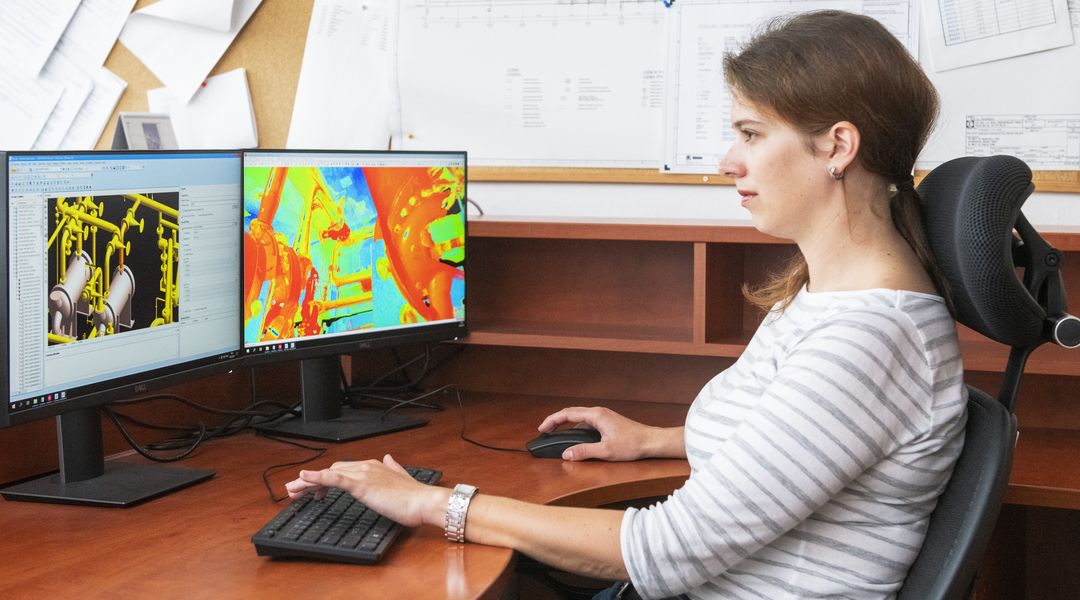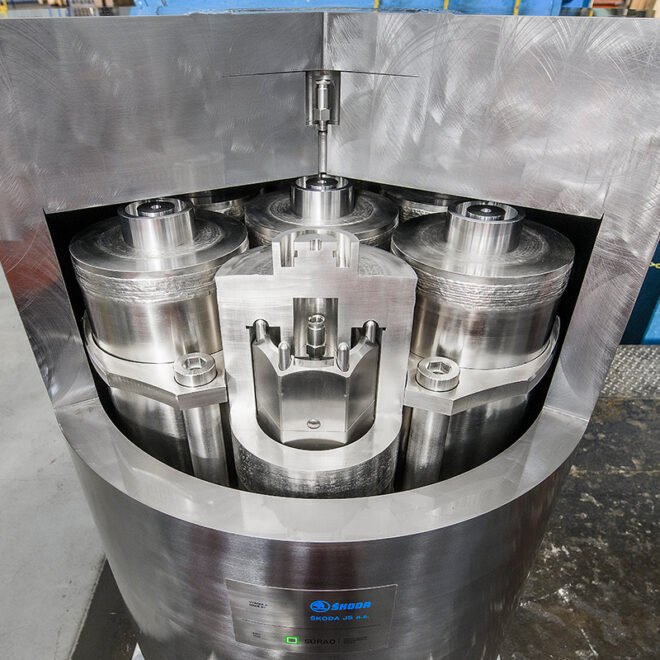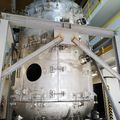Design

Spatial Coordination at the Mochovce, Bohunice, Dukovany and Temelín NPPs

At the beginning of 2018, we started creating a 3D model of the actual condition for the post-installation cleaning operations stage at Mochovce NPP Unit 4. The result is documentation for approximately 2,800 pipeline routes and auxiliary steel structures. Approximately 140 scans of the main production unit technology served as the basis for this work. In parallel, we have developed a 3D model of the steam-water piping system (from the steam generator to the hermetic penetration) at Dukovany NPP Units 1, 2 and 4. This model was prepared from scans taken in the main production unit buildings.
Since 2019, activities related to the finalization of the Unit 4 completion project at Mochovka NPP are continuing successfully. In the period 2019-2021, documentation of the actual design for approximately 1,600 pipeline routes and auxiliary steel structures was prepared.
Spatial coordination using E3D tools and laser scanning is increasingly being used to check the actual condition after installation, prior to submitting individual plant designs for construction testing and to verify and produce final as-built documentation. Among other things, it is also used to verify the original documentation of old equipment delivered during the original construction of Mochovce 3,4 NPP (verification of the actual dimensions of the equipment against the original documentation). Data from approximately 400 additional scans with many individual sites were used as a basis for all these activities.
The project “F972 – TQ, TX – transport of inaccessible 6kV motors” has been implemented for the Temelín NPP. This was a challenging project, which aimed to identify the transport routes where the currently inaccessible large motors (24 motors weighing 3-5 tonnes in total) of the TX and TQ emergency power systems could be transported out of the main production unit if necessary incl. finding any collisions on the transport routes. The final output was technical reports describing the transport of each motor separately.
After the transport routes were laid out, the first step was to scan all the affected areas (30 scans were carried out, with a total of 581 scanner stations). This was followed by the refinement of the E3D model of Temelín NPP supplied by the client within the scope of the defined transport routes. These data were finally collected in the Virtual Reality department, where the animation of individual transports was processed and the collision technology was defined. Based on these findings, the final technical reports could then be elaborated.
Since 2023, the digitalization of design at Temelín and Dukovany NPPs has been intensively underway. All mechanical design workers have been granted access to ČEZ systems and design tools. The group is thus directly involved in the trial operation and testing of ČEZ tools for the digital transfer of documentation, design data or the exchange of design documents. Thanks to this opportunity, ŠKODA JS can participate in the creation and tuning of these systems.
As part of service and overhaul activities at Czech nuclear power units, it is possible to capitalize on previous experience with recording and verifying the actual state. Modern technologies are used for design (3D scanning, various types of SW related to digitization or data processing, 3D modeling).
Emergency Containment Depressurization (Venting) at Ukrainian Nuclear Power Plants

This project, including the design, deliveries, assembly and commissioning, is being implemented by ŠKODA JS in cooperation with the FRAMATOME Company and other companies at eleven VVER 1000 nuclear units in Ukraine. The design phase of the project took place in 2018. The complete documentation was prepared in line with the GOST and PNAEG standards. Venting is a passive system, which in the event of an increase in pressure inside the containment will release, through a filtration system, a mixture of steam and gas into the surrounding environment.
The two-stage filtration process itself takes place in the vessel and the required filtration effectiveness is 99.999%. The system also serves to remove heat from the containment, which is achieved by steam condensation inside the vessel.
ŠKODA JS supervised the assembly of the systems and directly managed the installation and welding of the main pressure vessel of each system.
Cask for Leaky Spent Fuel for the Temelín NPP
We are ready to offer our customers a packaging assembly (cask) for leaky used fuel. Its main feature is that it allows to accommodate not only individual fuel rods (removed from fuel assemblies), but especially entire fuel assemblies, where one of the fuel rods is leaking, without the need to remove them.
The development of the cask was based on a modification of the existing design of our own ŠKODA 1000/19M cask for VVER-1000 type used fuelDue to the risks associated with leaking fuel, we paid the greatest attention to the safe handling procedure, especially the drying of packaging assemblies at the nuclear power plant, during the design and construction phase of development. To this end, in addition to calculations and analyses, we performed a number of verification experiments. The result of cooperation with expert bodies is the ŠKODA 1000/19N packaging assembly.
Deep disposal – end of fuel cycle
ŠKODA JS completed the project “Research and Development of a Storage Cask for Deep Disposal of Used Nuclear Fuel”. The aim was to completely design a storage cask for deep disposal of used nuclear fuel from VVER 440 reactors and supply a sample of this cask to the Radioactive Waste Repository Authority (SÚRAO). This used fuel cask sample for VVER-440 fuel is currently displayed in the Faculty of Mechanical Engineering of the University of West Bohemia. Currently, ŠKODA JS is involved in an expert group that is addressing the further development of the deep repository.
Science and Research

Within subsidy programs, we intensively worked with the Generation IV reactor technology based on molten salt and helium. We also developed a Hydrogen Steam Autoclave for the Řež Research Center. The new system allows for testing of changes to material properties in an environment of overheated water steam with an addition of hydrogen, a hydrogen steam mixture. One of the effects examined is, for example, hydrogen embrittlement.
As part of ŠKODA JS’ internal development, we are also participating in development of our own experimental program focusing on hydraulic testing of fuel assemblies. Extensive measurements of new types of fuel assemblies for VVER-1000 and VVER-440 technology are being carried out on modernized experimental stands. These experimental activities were carried out within the framework of the development of licensing documentation and overall licensing management of introduction of new fuel types at Temelín and Dukovany. We also focused on the project of the overall modernization of the experimental stand for measuring critical heat flows. This is a unique device for a comprehensive study of critical heat flows on a bundle of heated rods for pressurized water reactors. From the measurements performed, it is clear that it meets the latest requirements for measuring critical heat flows for most of the world’s manufacturers of fuel assemblies for pressurized water reactors.
Another current project is the support of water loops. Experience with the comprehensive modernization of our own experimental device can now be used and focus e.g. on a new pressurized water loop with an experimental channel located in the vessel of the LVR-15 research reactor at the Řež Research Center.
The history of our cooperation

2018 the creation of a 3D model of the actual state of the post-assembly clean-up operation at Unit 4 of the Mochovce NPP

2019a 3D model of the piping of the steam/water system (from the steam generator to the hermetic penetration) in Units 1, 2 and 4 at the Dukovany NPP was created

2021design work on the development of a new packaging assembly for leaking used fuel VVER 1000

2022designing digitalization at Temelín and Dukovany NPPs is in full swing

2023implementation phase of the project “Emergency depressurization in containment (Venting) at Ukrainian nuclear power plants”
Interesting numbers
2800 pipelines and auxiliary steel structures at Unit 4 of the Mochovce NPP scanned